
Consumer Insights
Uncover trends and behaviors shaping consumer choices today
Procurement Insights
Optimize your sourcing strategy with key market data
Industry Stats
Stay ahead with the latest trends and market analysis.
The global wind turbine market attained a value of USD 122.18 Billion in 2025, fuelled by the increasing renewable energy adoption, grid stability needs, and electric vehicle integration. The industry is expected to grow at a CAGR of 8.60% during the forecast period of 2026-2035, to reach USD 278.80 Billion by 2035. The market is likely driven by the rising renewable energy capacity, increased electrification, and the transition to cleaner power sources.
Base Year
Historical Period
Forecast Period
Policy support and large-scale investments have propelled the wind turbine industry. As per the 2024 data released by International Renewable Energy Agency, yearly average investment in renewable power generation is expected to reach USD 1300 billion by 2030, which was USD 486 billion in 2022. This surge is expected to triple renewable power capacity, on a global level.
The integration of wind and solar power generation is gaining traction, particularly in regions with high solar potential. According to Western Wind and Solar Integration Study (WWSIS) conducted in 2025, it was found that achieving a 35% share of solar and wind energy in the power grid sector could reduce the fuel costs by 40% and also curb carbon emissions by 25% - 45%, which is equivalent to removing 22 to 36 million cars from the road.
China is cementing its position as the global leader in renewables development. By Q3 of 2024, China had 39.1 million kilowatts of offshore wind power connected to its national grid, accounting for half of the global installation.
Compound Annual Growth Rate
8.6%
Value in USD Billion
2026-2035
*this image is indicative*
|
Global Wind Turbine Market Report Summary |
Description |
Value |
|
Base Year |
USD Billion |
2025 |
|
Historical Period |
USD Billion |
2019-2025 |
|
Forecast Period |
USD Billion |
2026-2035 |
|
Market Size 2025 |
USD Billion |
122.18 |
|
Market Size 2035 |
USD Billion |
278.80 |
|
CAGR 2019-2025 |
Percentage |
XX% |
|
CAGR 2026-2035 |
Percentage |
8.60% |
|
CAGR 2026-2035- Market by Region |
Asia Pacific |
9.0% |
|
CAGR 2026-2035 - Market by Country |
China |
13.0% |
|
CAGR 2026-2035 - Market by Country |
UK |
10.6% |
|
CAGR 2026-2035 - Market by Component |
Rotator Blade |
9.8% |
|
CAGR 2026-2035 - Market by Installation |
Offshore |
9.8% |
The global wind turbine market value plays a pivotal role in achieving net-zero emissions by enabling the large-scale deployment of wind power, one of the most mature and scalable renewable energy sources. As the levelized cost of energy (LCOE) for onshore wind fell from 0.089/kWh to USD 0.039/kWh between 2010 and 2023, wind turbines are becoming increasingly cost-competitive. Governments are ramping up efforts to expand wind capacity: For instance, according to the data released by Global Wind Energy Council in 2025, the European Union aims to install 111 GW of new wind power between 2024 and 2030, while China added a record-breaking 75 GW of wind capacity in 2023 alone. These trends highlight wind energy’s central role in reducing reliance on fossil fuels, improving energy security, and driving the global energy transition.
Wind Power Surges Globally with Innovation and Policy Backing
The wind turbine industry is witnessing significant growth, propelled by falling costs, technological advancements, and strong policy support. According to the projections by Global Wind Energy Council (GWEC), the offshore wind is expected to hold a growing share of new capacity—rising from 11.8% to 17.5% from 2024 to 2030. Additionally, the U.S. Department of Energy projects that wind could supply 30% to 35% of the country’s electricity by 2050, up from just over 10% in 2023. Meanwhile, India plans to boost the wind capacity to 140 GW by 2030 as part of its 500 GW non-fossil goal. These targets reflect a fast-growing market, supported by advances in turbine size, digital controls, and grid integration.
Similarly, in March 2023, Siemens Gamesa launched the SG 14-236 DD offshore wind turbine, delivering up to 15 MW per unit. The model was selected for deployment at the 2.9 GW North Sea Titan Wind Farm, with installation scheduled to begin in 2026. The project will provide electricity for over 3 million homes in Germany, reflecting Europe's growing offshore wind ambitions.
The global wind turbine market is driven by advancements in turbine technologies, increasing investment in offshore wind energy, and rising demand for renewable energy sources.
The continuous demand for higher efficiency and lower cost-per-megawatt has led to breakthroughs in wind turbine technology. Offshore turbines have seen major advancements, such as the development of floating wind turbines, allowing turbines to be deployed in deeper waters with higher wind speeds. In 2023, the world's first fully operational floating wind farm in Norway, Hywind Tampen, achieved commercial operations with a capacity of 88 MW, showcasing the viability of this technology. Similarly, onshore turbines are benefiting from larger rotor blades and taller towers, maximizing energy production in low-wind regions.
Investment in offshore wind energy has surged globally, driven by government policies and the urgent need to decarbonize energy systems. According to the International Renewable Energy Agency (IRENA), offshore wind power capacity is projected to grow by ten-fold (to 228 GW) through 2030 and 1,000 GW by 2050. The European Union has committed to increasing its offshore wind capacity to 60 GW by 2030. In addition, the US is making significant strides with the government’s goal of installing 30 GW of offshore wind capacity by 2030, with an investment of USD 12 billion expected in the 10 years. Offshore wind farms, such as the 3.6 GW Vineyard Wind project in Massachusetts, are part of a growing wave of large-scale offshore developments.
The rising demand for renewable energy sources has fueled the expansion of the wind turbine market. According to the Global Wind Energy Council (GWEC), the wind industry installed a 117 GW of new capacity, on a global level, in 2024, and is expected to reach almost 1TW by 2030, with China, the United States, and Europe leading the way in installations. The wind industry has also become a key job creator. As of 2025, the wind turbine manufacturing sector alone employs over 1.5 million people worldwide. With countries aiming to decarbonize their energy grids, job growth is expected to continue in the turbine manufacturing, operation, and maintenance sectors. In addition, wind energy jobs are diversifying, with roles in project development, engineering, and logistics seeing significant increases.
The advancement is wind turbine blades and overall design can immensely enhance the power generation capacity of the wind turbine. For instance, a recent NREL study conducted in 2023, has indicated that technology innovations have a potential to add over 80% economically viable wind energy capacity in 2025. Moreover, by using flexible control mechanisms that adjust the angle of wind turbine blades and regulate generator speed, plant operators can direct individual turbines to minimize their impact on downstream turbines. This can enable existing facilities to achieve annual energy production gains of 1%–2%.
Wind Turbine Market Grows Amid Renewable Push and Technology Advances
The rapid increase in renewable electricity generation is a core driver of the growth of wind turbine market. Global wind energy generation is projected to reach 3,000 TWh by 2030, up from 2,100 TWh in 2023, according to the International Energy Agency (IEA). Offshore wind is emerging as a key segment, with 500 GW of capacity expected globally by 2050, up from 64 GW in 2023. Key innovations include floating wind platforms, taller turbine towers, and digital wind farm analytics. Countries like the United Kingdom aim to reach 50 GW of offshore wind by 2030, set by the British Energy Security Strategy (BESS). These factors are accelerating deployment through competitive auctions and streamlined permitting. These trends support wind power’s role in delivering clean, stable, and scalable electricity.
Emerging Technologies and Repowering Presents Significant Opportunities
Significant opportunities are emerging in floating offshore wind technology, hybrid wind-solar systems, and turbine repowering, thus supporting the wind turbine market expansion. The World Bank estimates over 7,000 GW of floating wind potential worldwide, particularly in deepwater zones of Japan, the U.S. West Coast, and the Mediterranean. In April 2025, Japan approved its first commercial-scale floating wind project, totaling 250 MW, set to be operational by 2028.
Another opportunity lies in repowering ageing wind farms: in Germany alone, over 16 GW of turbines are more than 15 years old and eligible for upgrade. Additionally, digital wind farm management tools are enabling real-time performance optimization, lowering maintenance costs and maximizing output.
“The EMR’s report titled “Wind Turbine Market Report and Forecast 2026-2035” offers a detailed analysis of the market based on the following segments:
Breakup by Axis Type
Breakup by Installation
Breakup by Component
Breakup by Application
Breakup by Region
Horizontal Axis Wind Turbines Dominate Market with Higher Efficiency and Output
According to wind turbine market analysis, the horizontal segment was the largest revenue generator in 2023. Horizontal axis wind turbines are more efficient than vertical axis wind turbines because they can generate more electricity from the same amount of wind and their components or parts are easily accessible. Moreover, these types of blades are much larger in size as compared to vertical axis blades, resulting in much more energy generation as compared to other axis type.
Vertical axis wind turbines have their axis perpendicular to the ground. These are suitable for smaller places, where energy requirement is not that high. Moreover, these blades are less noisy as compared to horizontal axis types of wind turbines and have low speed too.
Onshore Turbines Drive Global Wind Capacity
The onshore segment holds the highest share in the global wind turbine market. The onshore wind energy is the power that’s generated by wind turbines located on land driven by the natural movement of the air. These types of wind turbines require less time and resources for construction and hence are less expensive as compared to offshore wind turbines. As per data by International Energy Agency, in 2023, of the total 1015 GW of wind capacity installed, 93% was in onshore systems.
Advancements in Rotor Blade Design Drive Wind Turbine Efficiency
Rotor blades hold a dominant position in the global wind turbine market. Modern wind turbines use longer and lighter composite blades, typically made from fiberglass or carbon fiber, to increase swept area and power output. As of 2024, rotor blades for onshore turbines have reached lengths of up to 85 meters, while offshore blades now exceed 100 meters, such as those on Siemens Gamesa’s SG 14-236 DD with 115-meter blades.
Gearboxes transform the turbine blades' low-speed rotation into a high-speed rotation that can produce electricity. Their main application is in geared wind turbines, which are still common in onshore installations because of their low cost.
Industrial Sector Leads Global Wind Turbine Adoption
The market for wind turbines worldwide is dominated by the industrial segment. Wind energy helps industries meet ESG commitments, decarbonize operations, and offset high electricity costs. Investments in on-site or PPA-based wind energy projects are growing in the heavy manufacturing, mining, and chemical industries. For example, Tata Steel announced in November 2024, that it would reduce its carbon footprint by 50,000 tons per year by implementing a 120 MW wind project in India to power its industrial operations.
Moreover, the commercial segment primarily addresses energy requirements in data center and business environments. More than 40% of Amazon and Google's worldwide electricity needs are currently met by wind, and in 2024, they increased their wind PPA portfolios in the US and Europe to power data centers.
|
CAGR 2026-2035 - Market by |
Country |
|
China |
13.0% |
|
UK |
10.6% |
|
India |
9.9% |
|
Germany |
9.8% |
|
Australia |
7.8% |
|
Japan |
7.5% |
|
France |
7.4% |
|
Italy |
5.8% |
|
USA |
XX% |
|
Canada |
XX% |
|
Saudi Arabia |
XX% |
|
Brazil |
XX% |
|
Mexico |
XX% |
Asia Pacific leads the wind turbine market growth with strong contributions from China and India
Asia Pacific is the fastest-growing region, led by China, which alone added 55 GW of new capacity in 2023, bringing its cumulative total to 430 GW. India also saw a revival with 2.5 GW of new installations in 2023 and aims for 140 GW by 2030. Australia, Vietnam, and South Korea are emerging markets investing in both onshore and offshore wind. Japan and South Korea are focusing on floating offshore wind projects, with multiple gigawatt-scale developments in the pipeline. The Asia Pacific market is expected to surpass 600 GW of installed capacity by 2030, driven by ambitious national targets, supportive policies, and the urgent need to transition from coal.
North American wind turbine industry is driven by the decarbonization targets, and favorable wind resources
The wind turbine industry in North America is advancing rapidly, spurred by government incentives, decarbonization targets, and favorable wind resources. As of 2023, the U.S. wind power capacity reached 147 GW, with over 10.2 GW added in that year alone. Texas continues to lead, with over 40 GW installed, followed by Iowa and Oklahoma. Offshore wind is also gaining traction, with the Vineyard Wind 1 project off the coast of Massachusetts expected to generate 800 MW by 2025. Canada has over 15 GW of wind capacity, with Alberta and Ontario being the major contributors. Looking ahead, the North American market is projected to reach 200 GW of total wind capacity by 2030, driven by both utility-scale projects and distributed generation in rural areas.
The global wind turbine market is evolving rapidly, driven by technological innovation, increasing renewable energy demand, and supportive policies. Key players are investing in offshore and onshore turbine advancements, larger capacity models, and digitalization to improve efficiency, reduce costs, and accelerate the global energy transition.
Founded in 1945 and headquartered in Denmark, Vestas Wind Systems A/S is offers sustainable energy solutions, specializing in the design, manufacture, installation, and maintenance of wind turbines across onshore and offshore markets. The company has installations in over 88 countries and over 164 GW of wind turbines installed worldwide.
Based in Germany, and founded in 1847, Siemens AG operates across multiple industrial verticals with Siemens Gamesa Renewable Energy (SGRE) as its wind energy business vertical. SGRE is a major force in offshore wind, delivering over 130 GW globally. Siemens also integrates digital twin technology and condition monitoring systems to improve turbine lifecycle and reliability, aligning with the global shift toward smart energy infrastructure.
Founded in 1892 and located in New York, United States, General Electric (GE) operates across energy, aviation, and healthcare sectors. GE Renewable Energy, a division of GE, focuses on wind, hydro, and solar power. As of 2025, GE has installed over 50,000 wind turbines globally. The company continues to pioneer hybrid wind-storage systems, incorporating battery storage with wind energy to address intermittency and grid stability challenges, especially in North American and Asian markets.
Founded in 1998 and headquartered in Beijing, China, Goldwind is one of the largest wind turbine manufacturers globally. The company focuses on permanent magnet direct drive (PMDD) technology, offering reliable and low-maintenance wind solutions. Goldwind has installed more than 100 GW of wind power capacity, Goldwind also invests in digital wind farm platforms and smart operation centers to enhance predictive maintenance and reduce O&M costs across large-scale wind farms.
*Please note that this is only a partial list; the complete list of key players is available in the full report. Additionally, the list of key players can be customized to better suit your needs.*
Other key players in the wind turbine market report include Envision Group, Mingyang Smart Energy Group, Nordex SE, Enercon GmbH, Suzlon Energy Limited, Shanghai Electric Wind Power Group Co., Ltd., among others.




*While we strive to always give you current and accurate information, the numbers depicted on the website are indicative and may differ from the actual numbers in the main report. At Expert Market Research, we aim to bring you the latest insights and trends in the market. Using our analyses and forecasts, stakeholders can understand the market dynamics, navigate challenges, and capitalize on opportunities to make data-driven strategic decisions.*
Get in touch with us for a customized solution tailored to your unique requirements and save upto 35%!
In 2025, the market reached an approximate value of USD 122.18 Billion.
The market is projected to grow at a CAGR of 8.60% between 2026 and 2035.
The market is driven by rising renewable energy capacity, advancements in turbine technologies, increased electrification, and the transition to cleaner power sources.
The Asia Pacific market is expected to be driven by ambitious national targets and supportive policies.
The major players in the market are Vestas Wind Systems A/S, Siemens AG, General Electric Company, Goldwind Science&Technology Co.,Ltd., Envision Group, Mingyang Smart Energy Group, Nordex SE, Enercon GmbH, Suzlon Energy Limited, Shanghai Electric Wind Power Group Co., Ltd., among others.
Explore our key highlights of the report and gain a concise overview of key findings, trends, and actionable insights that will empower your strategic decisions.
| REPORT FEATURES | DETAILS |
| Base Year | 2025 |
| Historical Period | 2019-2025 |
| Forecast Period | 2026-2035 |
| Scope of the Report |
Historical and Forecast Trends, Industry Drivers and Constraints, Historical and Forecast Market Analysis by Segment:
|
| Breakup by Axis Type |
|
| Breakup by Installation |
|
| Breakup by Component |
|
| Breakup by Application |
|
| Breakup by Region |
|
| Market Dynamics |
|
| Competitive Landscape |
|
| Companies Covered |
|
Datasheet
One User
USD 2,499
USD 2,249
tax inclusive*
Single User License
One User
USD 3,999
USD 3,599
tax inclusive*
Five User License
Five User
USD 4,999
USD 4,249
tax inclusive*
Corporate License
Unlimited Users
USD 5,999
USD 5,099
tax inclusive*
*Please note that the prices mentioned below are starting prices for each bundle type. Kindly contact our team for further details.*
Flash Bundle
Small Business Bundle
Growth Bundle
Enterprise Bundle
*Please note that the prices mentioned below are starting prices for each bundle type. Kindly contact our team for further details.*
Flash Bundle
Number of Reports: 3
20%
tax inclusive*
Small Business Bundle
Number of Reports: 5
25%
tax inclusive*
Growth Bundle
Number of Reports: 8
30%
tax inclusive*
Enterprise Bundle
Number of Reports: 10
35%
tax inclusive*
How To Order

Select License Type
Choose the right license for your needs and access rights.

Click on ‘Buy Now’
Add the report to your cart with one click and proceed to register.

Select Mode of Payment
Choose a payment option for a secure checkout. You will be redirected accordingly.
Gain insights to stay ahead and seize opportunities.
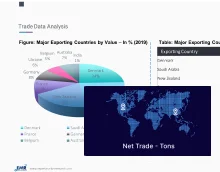
Get insights & trends for a competitive edge.
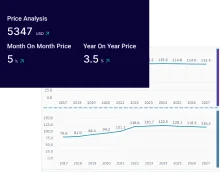
Track prices with detailed trend reports.
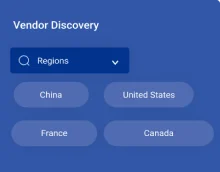
Analyse trade data for supply chain insights.

Leverage cost reports for smart savings
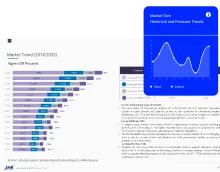
Enhance supply chain with partnerships.
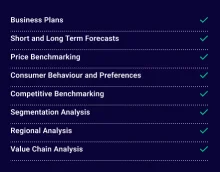
Connect For More Information
Our expert team of analysts will offer full support and resolve any queries regarding the report, before and after the purchase.
Our expert team of analysts will offer full support and resolve any queries regarding the report, before and after the purchase.
We employ meticulous research methods, blending advanced analytics and expert insights to deliver accurate, actionable industry intelligence, staying ahead of competitors.
Our skilled analysts offer unparalleled competitive advantage with detailed insights on current and emerging markets, ensuring your strategic edge.
We offer an in-depth yet simplified presentation of industry insights and analysis to meet your specific requirements effectively.
Share